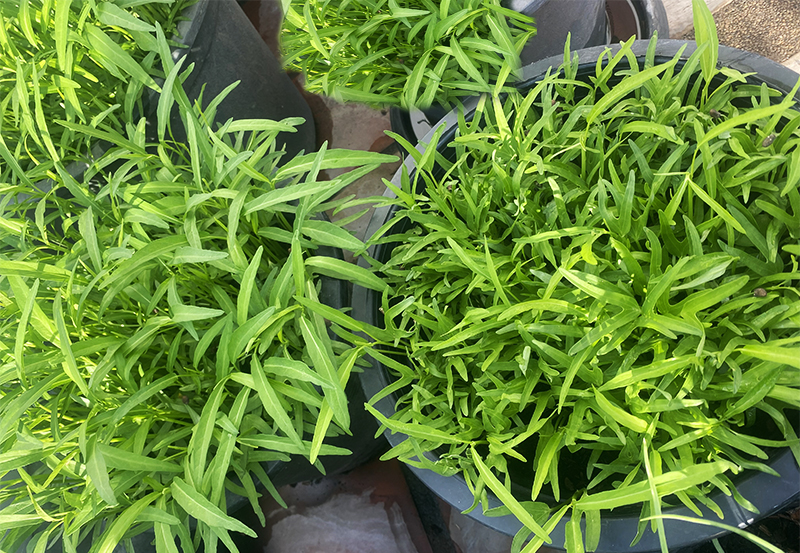 Morning-glory (IPOMOEA AQUATICA) Morning-glory (IPOMOEA AQUATICA)
Thai name: Phak bung, Kom-chon, Phak thot yot, No-doh Herbaceous plant, floating or creeping, found in wet sites such as swamps or canals, wild or cultivated. Stem hollow, rooting at the nodes, red or white. Leaves triangular-acuminate, sagittate or sometimes linear, glabrous, 7-9 cm long, 3.5-7 cm wide; petiole 3-6 cm long. Inflorescence axillary, with a 1-2 cm-long peduncle; flowers 1-2 together, bell-shaped, 4-5 cm long, 3.5 cm wide or more, pinkish, with violet tube. Capsule globose, 7-9 mm across; seeds finely reddish-brown hairy, 4 mm in diameter.
• The shoots, young leaves and fruit are blanched and eaten with Namphrik. The shoots and leaves are also put in Kaeng som or a curry made with dried salted fish heads, cooked with noodles or fried with fermented soybean sauce. They are rich in vitamin A.
|
|
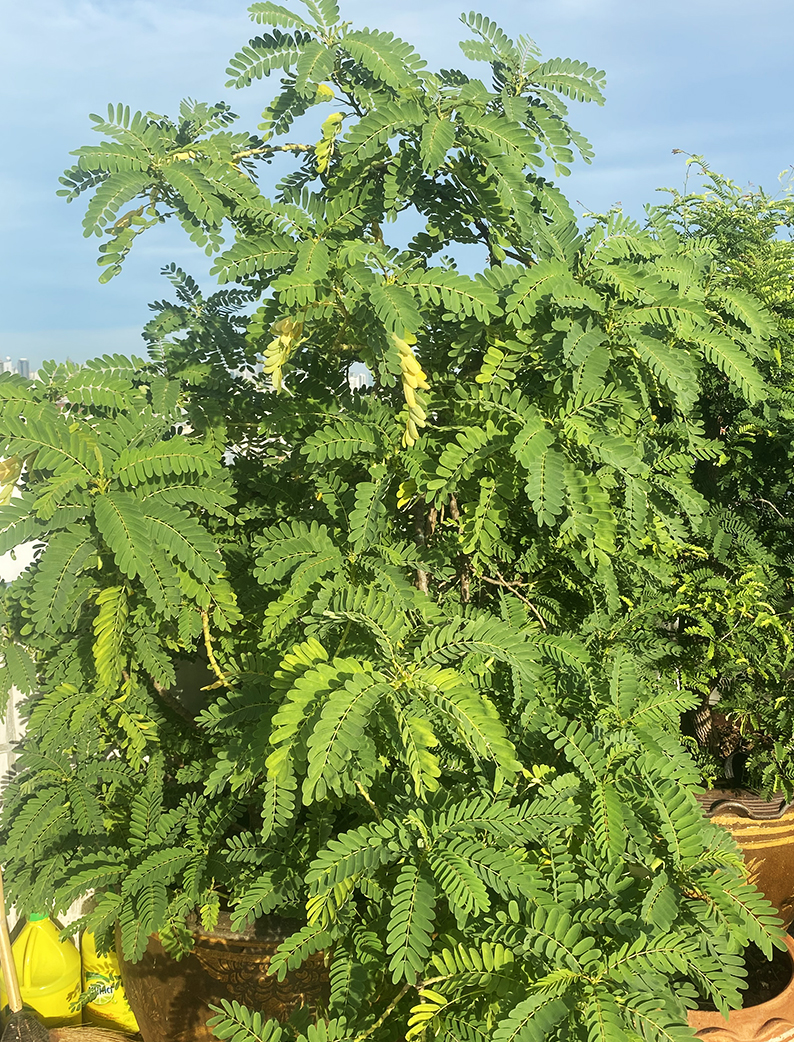
Bignoniaceae (DOLICHANDRONE SERRULATA)
Thai name: Khoe khaao, khoe ketthawaa, khae saai, khae nae, khae foi, khae paa, khae phuu ho, khoe yot dom, khoe yaao, khae aao
Wild tree, 7-20 m high, found in open mixed deciduous forest and common in ricefields in the north, north-east and south-east of Thailand. Leaves pinnate, 12-35 cm long; leaflets elliptic or ellipticobovate, acuminate, oblique at the base, 5-10 cm long, 3-5 cm wide. Inflorescence of racemes, 2-3 cm long; flowers 3-7 together, funnelshaped, 11-19 cm long, with a slender cylindrical tube and 5 fringed lobes. Capsule twisted, acuminate, up to 85 cm long, 1.2-1.8 cm wide, seeds rectangular, thin, winged, 2.2-2.8 cm long, 5-8 mm wide. The flowers are blanched and served with nam phrik or put into kaeng som.
|
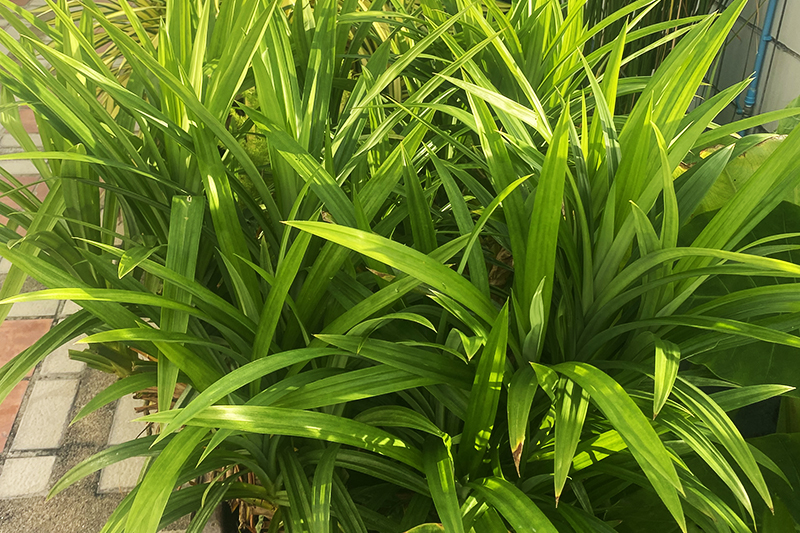 Pondonaceae (PANDANUS AMARYLLIFOLIUS) Pondonaceae (PANDANUS AMARYLLIFOLIUS)
Thai name: Toei hom, paande wo-nging, Pondonus, fragrant screw pine Shrub,
1-2 m high, commonly cultivated. Adventitious roots at the base of the trunk. Leaves spirally arranged, linear, plicate, 75 cm long, 2.5 cm wide, or larger, fragrant, sessile. Very rarely observed flowering. The leaves are cooked with rice to give it a fragrant flavour. They are also used to make a juice or a green food colouring which is the whole plant is diuretic. The roots are antidiabetic, while the leaves are suited to treating skin diseases. The leaves are used in bouquets and to make small containers for desserts. They are also mixed with another ingredient to produce perfume.
|
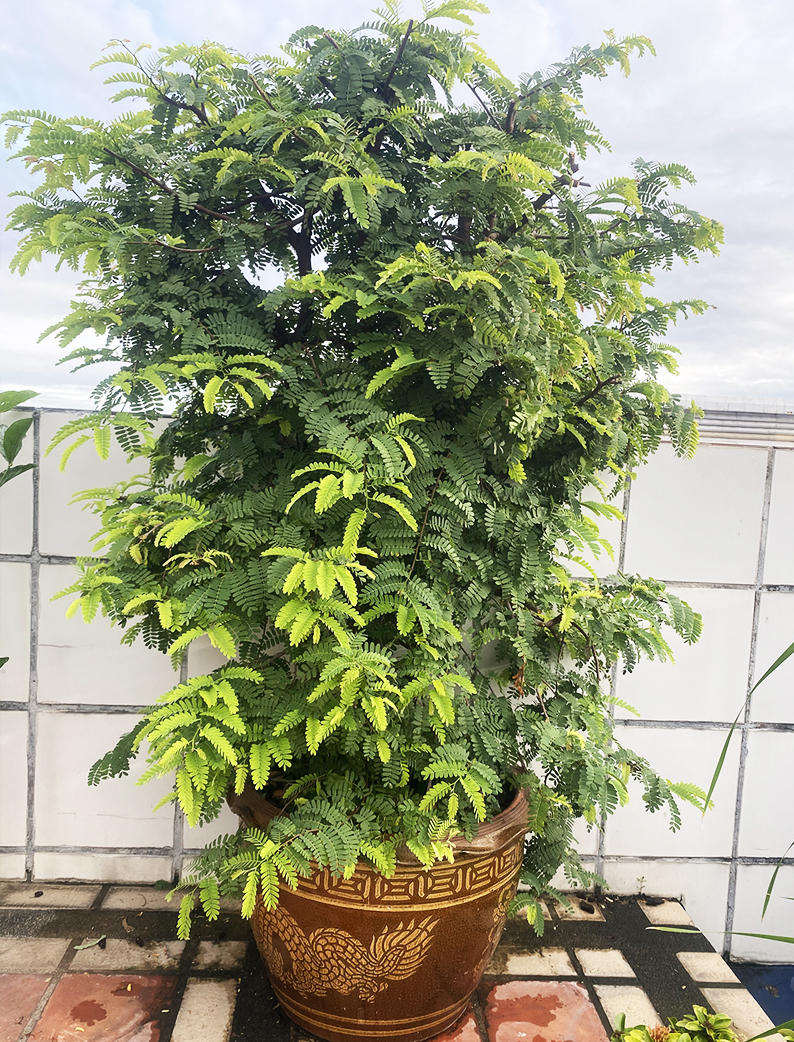 Leguminosoe-Coesalpinioideae (TAMARINDUS INDICA) Leguminosoe-Coesalpinioideae (TAMARINDUS INDICA)
Thai name: Mo khaam, ta luup, mong khlong, mot-le, saa-mo-kle, maak kaeng, am-pian Tamarind fibrous, pulpy
Cultivated tree, up to 20-25 m high. Leaves pinnate, 5-12 cm long with the petiole; leaflets 10-12 pairs, oblong-linear, unequal, mucronate, finely velvety, 2-6 cm long; flowers with 3 unequal petals, about 1.2 cm glabrous, 8-30 mm long, 3-9 mm wide. Inflorescence of small racemes, long, yellowish-orange. Pod oblong, curved, thick, with a mesocarp, 5-15 cm long, 1-2.5 cm wide, brown; seeds 3-10, obovateorbicular, compressed, about 1 cm long, shiny dark brown.
• The young leaves have a sour taste and are eaten raw in fish salad, or instead of the ripe fruit in the hot sour soup, kaeng som. The flowers are also sour and can be eaten raw or cooked; they are used in a recipe for shrimp paste and chilli sauce and as an ingredient in hot sour soup.
When young, the fruit can be made into nam phrik ma khaam or eaten fresh with sweet shrimp paste; when mature but unripe it is put into syrup to make candied fruit, or fermented and eaten with phrik ka kriea, a mixture of crushed chilli, sugar and salt. When ripe, types is made into a juice which is added to soups and curries. The coffee substitute.
Seeds are roasted, then soaked in water and eaten soft, or used as a Tamarind has a variety of medicinal functions. The bark is a febrifuge and an astringent, and the flowers help to reduce blood pressure. The fruit has a laxative effect, while the mature seeds are both a taenifuge and antidiarrheic.
|
 Coriander (Botanical Family: Umbelliferae) Coriander (Botanical Family: Umbelliferae)
Thai name: Phak chee Coriander leaf is claimed to be the world’s most commonly used herb, being indispensable in Southeast Asia, North Asia, India, the Middle East, Mexico and Spanish America.
Often referred to as Chinese parsley in tropical Asia (and as cilantro in the Americas), coriander is actually native to Southern Europe and has been used since ancient times. Although fresh coriander is sometimes used in Greek cooking, the dried seeds which are used as a spice are far more commonly encountered in the rest of Europe than the herb. The English name, coriander, comes from the Greek koris, which means a bug. (Those not enamoured of the herb claim it smells like bed bugs.)
Raw coriander leaves are widely used as a garnish and flavouring in tropical Asia, and are also pounded to make an excellent fresh chutney or dip in India. It may be reassuring to those who enjoy the distinctive flavour of fresh coriander to know that it is highly nutritious, being rich in calcium, phosphorous, B-carotene and Vitamin C. Strangely enough, only the Thais seem to have discovered that coriander root also makes an excellent seasoning. In Thailand, it is crushed together with garlic and black pepper to make the most widely used basic seasoning for Thai food.
While the fresh plant is probably the world’s most popular herb, the seeds of the coriander can claim to be the most commonly used spice throughout Asia. Coriander seeds are present in almost all blends of curry spices and in a number of other dishes, too. Their faintly orange scent is maximized if the seeds are lightly heated in a dry pan and then crushed to powder just before being cooked.
Fresh coriander grows easily in a pot or garden. Try planting the seeds purchased as a spice (although they may not germinate due to their age, or the fact that they may have been treated). For that reason it may be necessary to buy a packet of seeds intended for planting.
|
|
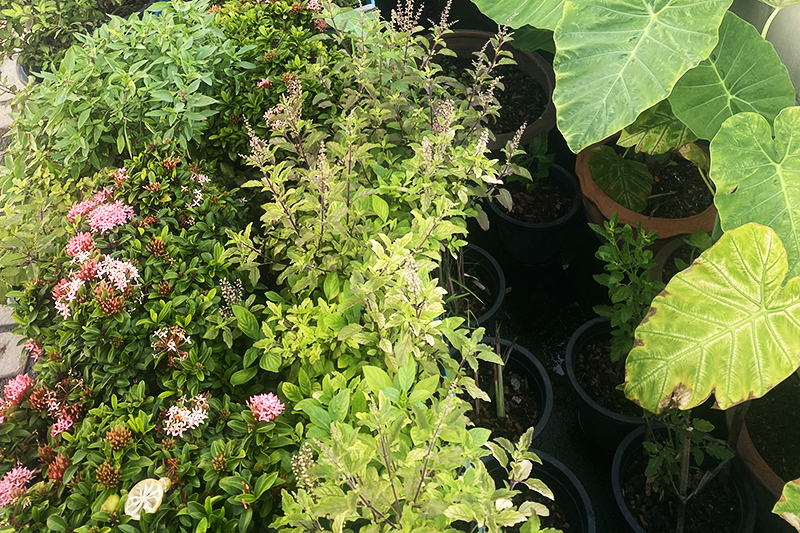
Basil (Ocimumbasilicum, O. americanum, O. tenniflorum, O. gratissimum)
Thai name: Bai horapa, bai manglak, bai kaprow
Three varieties of the wonderfully fragrant herb-basil-are found in tropical Asia. Identification by name can be somewhat confusing in Malaysia and Indonesia, as the names kemangi and selasih are often used interchangeably, or are used to describe one type of basil in one area and another type in a different region. However, the three plants are distinctly different in appearance and flavor.
The closest to European or sweet basil (O. basilicum) is the variety most commonly encountered in the region, especially in Thailand and Vietnam. This basil, which is known as baihorapa in Thailand, has intensely aromatic dark green leaves and purplish flower heads. It is often eaten raw as a herb in Thailand and Vietnam, served on a platter of fresh herbs which are added to lettuce wrappers for enclosing spring rolls, or nibbled with raw vegetables and a spicy dip. This basil is also added (often by the handful) to stir-fried chicken or beef, or to curries, particularly in Thailand.
Another variety of basil is markedly lemon scented; the leaves are slightly hairy, paler green and smaller than the sweet basil. Lemon basil, which is called baimanglak in Thailand, is sometimes fried with seafood in Malaysia and Indonesia. The seed coats of this basil are mucilaginous; Thai cooks soak them in water until the seeds are swollen, then mix them with coconut milk to make a dessert.
“Holy” basil (kaprow in Thailand) is sacred to Hindus; this basil has narrower leaves than the two other varieties and is less commonly used in regional cuisines. The herb releases its flavor only when cooked, and is used with fish, chicken and beef.
All three types of basil can be grown easily in the garden or a pot on a verandah simply by putting several stems into the earth. Discard the leaves at the base of the stem, but keep the upper leaves. Water well and, within a few days, the stems will have taken root and will grow vigorously if given sufficient sunshine and water.
|
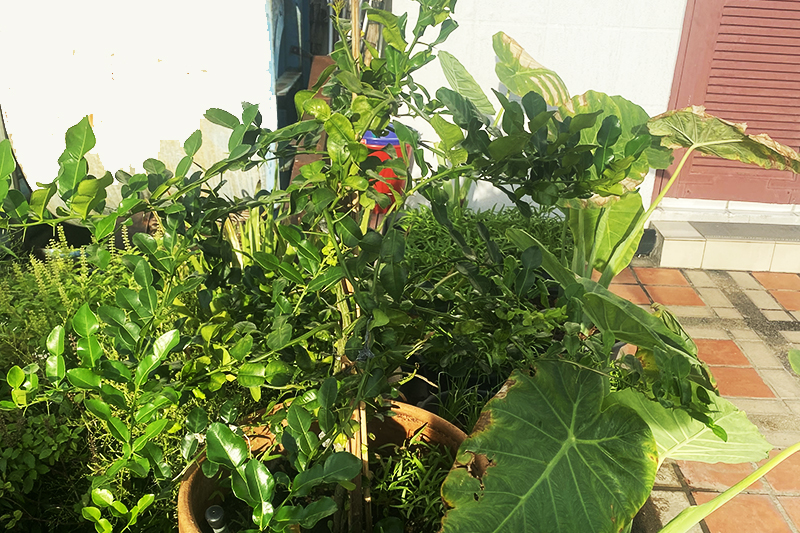 Kaffir Lime Leaf Kaffir Lime Leaf
Thai name: Bai magrut
The Kaffir lime has a dark green, warty skin which inspires an alternative name, leprous lime. There is virtually no juice inside, but the lime is valued for its zest and also for the marvelous perfume of its double leaf-no other lime or lemon or citrus can match it. Grated Kaffir lime rind is added to some dishes, while the distinctive leaves are also used as a herb, particularly in Thailand (a spicy tom yam soup [see page 25] would be unthinkable without these). Kaffir lime leaves are very finely shredded and added raw to some salads, or added to cooked food. They are often used by the Nonya cooks of Malaysia and Singapore, whose cuisine makes liberal use of fresh herbs.
It is sometimes difficult to find a regular supply of kaffir lime leaves in the markets; when you are able to obtain them, buy a large amount and store them in a sealed plastic bag in the deep freeze; they retain all their flavour and texture after a brief thawing out.
|
|
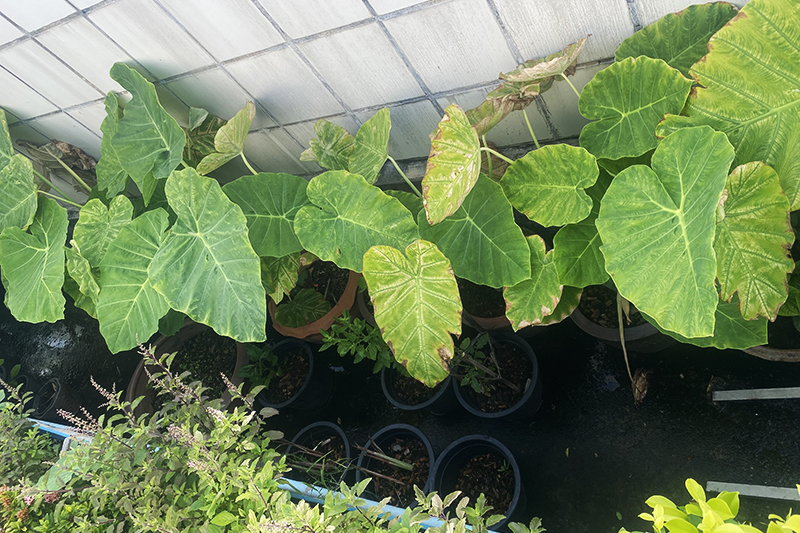
Colocasia esculenta
Vernacular name: bon
Common name: wild taro (English), satoimo (Japanese)
An erect, perennial herb, up to 1 m. or taller, storage stem (or corm) solid, cylindrical or spherical, up to 30 by 15 cm., usually brown, with lateral buds located above leaf scars. Leaves peltate consisting of long petiole and large, heart- shaped blade, 20-50 cm. long. Inflorescence a spadix, subtended by a yellow spathe, peduncle shorter than the petiole. Flower unisexual, small, sepals and petals absent; female flowers at base of spadix, green, and separated from the male flowers; spadix terminated by a sterile appendage; ovary unilocular, up to 67 ovules. Infructescence of densely packed berries. Seed less than 2 mm. long, ovate, and conspicuously ridged longitudinally. Common herb in wet place, growing naturally along canal bank from sea level to above 1,000 m. The plants thrive under full sun. Young leaf stalk is collected year round. The outer skin of the stalks are peeled off before boiling with some other sour additives such as tamarind pulp. The common dish cooked with wild taro stalk is a sweet and sour curry.
No planting of wild taro so far recorded in Thailand. Howerver they can be propagated by suckers and planted in muddy area.
|
|

Celery, (Apium graveolens)
Celery, herbaceous plant of the parsley family (Apiaceae). Celery is usually eaten cooked as a vegetable or as a delicate flavouring in a variety of stocks, casseroles, and soups. In the United States raw celery is served by itself or with spreads or dips as an appetizer and in salads. The tiny seedlike fruits, known as celery seed, resemble the plant itself in taste and aroma and are used as a seasoning, particularly in soups and pickles.
Native to the Mediterranean areas and the Middle East, celery was used as a flavouring by the ancient Greeks and Romans and as a medicine by the ancient Chinese. The ancient forms resembled smallage, or wild celery. Celery with large, fleshy, succulent, upright leafstalks, or petioles, was developed in the late 18th century. The stringiness that characterizes most celery has been eliminated from some varieties.
|
|
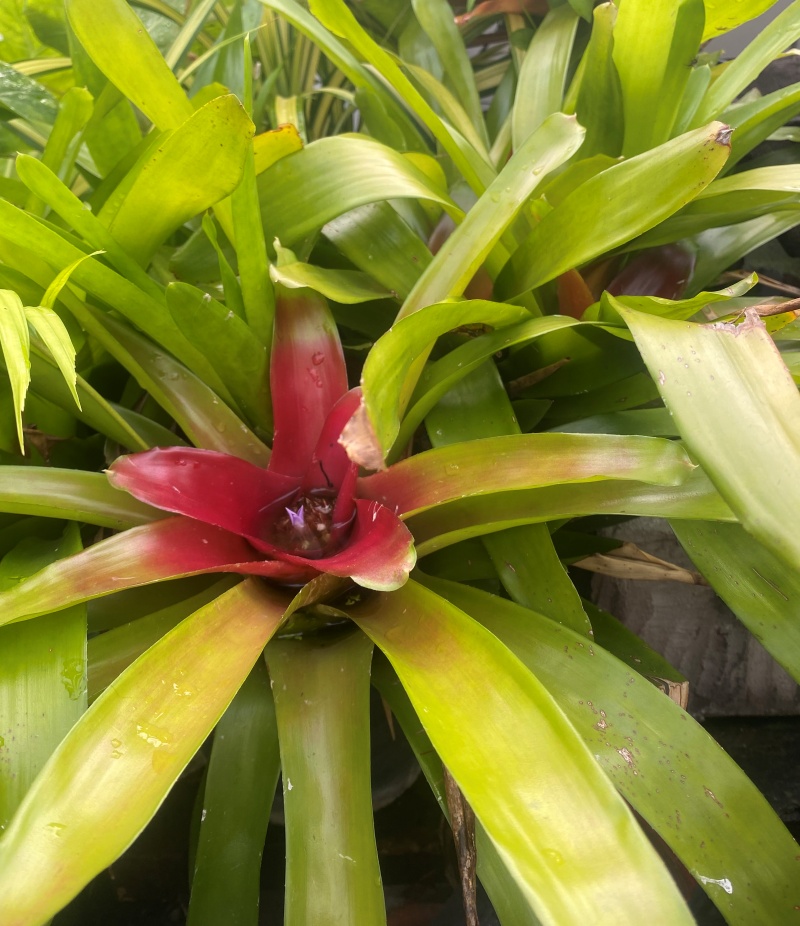
Bromeliaceae
Bromeliaceae, the pineapple family of the flowering plants (order Poales), with more than 3,000 species across 56 genera. All but one species are native to the tropical New World and the West Indies. Spanish moss (Tillandsia usneoides) and the edible fruit of the pineapple (Ananas comosus) are the major economic products of the family, though the fibrous leaves of some species (e.g., Aechmea magdalenae and Neoglaziovia variegata) are made into rope, fabric, and netting in some regions. Additionally, several species are cultivated indoors as ornamentals for their colourful flowers and foliage, and a number of epiphytic Tillandsia species, known as air plants, are sold as novelties.
Members of Bromeliaceae are herbaceous evergreen perennials with simple spirally arranged leaves. Many bromeliads are short-stemmed epiphytes that live in trees or on cacti, though a number are terrestrial. The flowers have three parts, like lilies but with contrasting sepals and petals, and are often borne in long spikes with distinctive coloured bracts. Most have fleshy fruit, but some produce dry capsules.
|
|

Crown of thorns, (Euphorbia milii)
Crown of thorns, also called Christ thorn, thorny plant of the spurge family (Euphorbiaceae), native to Madagascar. Crown of thorns is popular as a houseplant and is grown in warm climates as a garden shrub. Flowering is year-round but most plentiful in wintertime in the Northern Hemisphere. The common name refers to the thorny crown Jesus was forced to wear during his crucifixion, with the red bracts of the flowers representing his blood.
Crown of thorns is a hardy perennial with stout gray thorns and oval leaves that drop as they age. The sprawling, branching, vinelike stems can attain lengths of more than two metres (seven feet), though potted plants are considerably smaller. The small inconspicuous flowers are borne in paired clusters and are surrounded by two showy light red bracts (leaflike structures attached just below flowers). Various forms are available with yellow or deep red bracts. The white milky sap is poisonous and can cause skin and eye irritation.
|
|
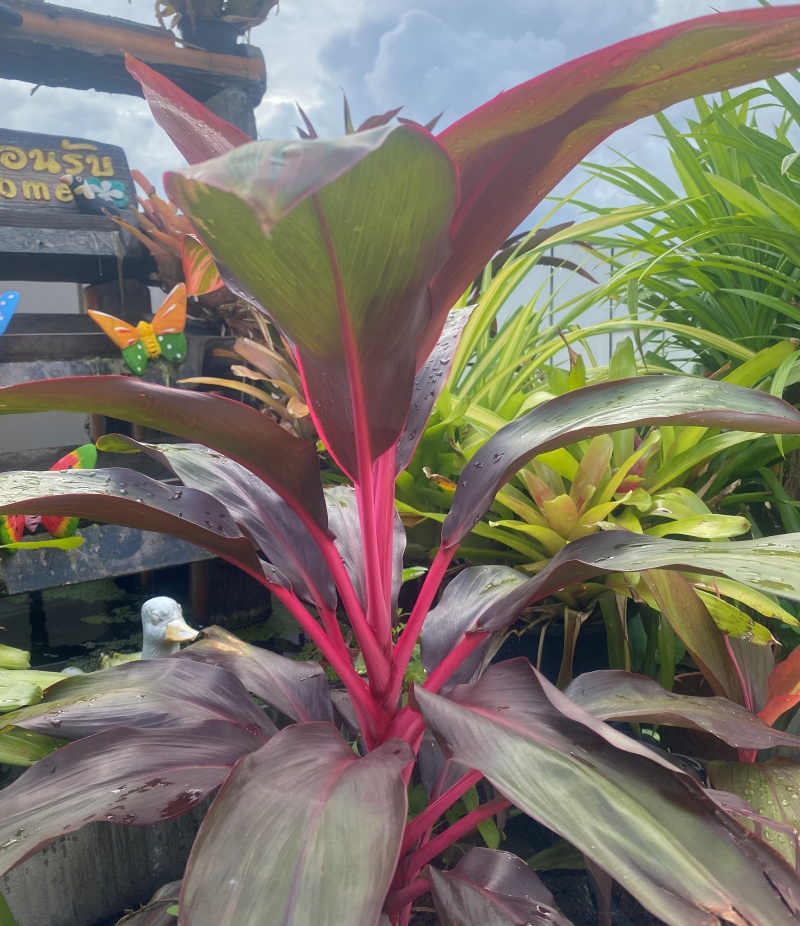
Dracaena (Red dracaena)
Dracaena, genus of about 170 species of flowering plants in the asparagus family (Asparagaceae). Members of the genus are native primarily to the Old World tropics, especially Africa, and one species is endemic to South America. Several Dracaena species are cultivated as houseplants for their ornamental foliage and are noted as effective air cleaners that remove chemicals, such as formaldehyde, from the air indoors.
The genus is fairly diverse. Most species have short ringed stalks and narrow sword-shaped leaves, though some resemble trees with crowns of leaves. Members of the former Sansevieria typically have short thick roots and long narrow basal leaves that stand erect. The small flowers are typically red, yellow, or green and produce berrylike fruit with one to three seeds.
|
|
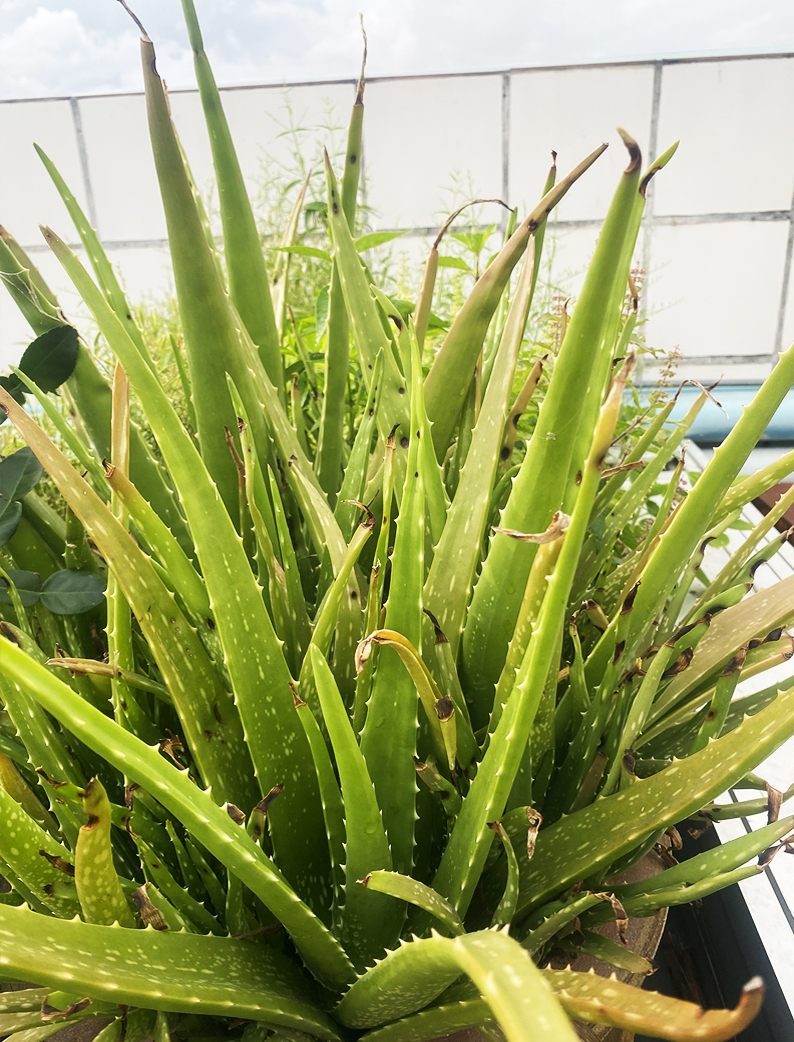
Aloe, (genus Aloe)
Aloe, genus of more than 500 species of shrubby succulent plants in the family Asphodelaceae native to Africa, Madagascar, and the Arabian Peninsula. Several species are cultivated as ornamentals and houseplants and for their medicinal leaves.
Most members of the genus have a rosette of leaves borne either at ground level or at the end of a stem. The leaves are usually succulent and fleshy and commonly have sharp toothed edges. Certain aloe species retain dense dead leaves around their stems to serve as insulation against the heat of wildfires. The tubular flowers range in colour from white to yellow to red. Many species are pollinated by non-hovering birds, such as sunbirds, and the flower clusters of such species are supported by tall sturdy stalks upon which the birds can land. The seeds are produced in dry capsules.
Several species are cultivated as ornamentals for their attractive architectural leaves and colourful flowers. Spiral aloe (Aloe polyphylla) is a popular specimen for its compact geometric spiral of spiny leaves. Arabian aloe (A. rubroviolacea) has long blue-green leaves with red teeth and is planted outdoors in warm climates; the leaves turn red if exposed to full sun. Snake, or mountain, aloe (A. broomii) is a common potted plant grown for its dense rosette of triangular leaves with dark teeth.
The juice of some species, especially the popular potted plant known as true aloe (Aloe vera), is used as an ingredient in cosmetics and in medicine as a purgative and as a treatment for burns. The gelatinous interior of the leaves is commonly applied directly to the skin as a beauty treatment or to soothe sunburns.
|
|
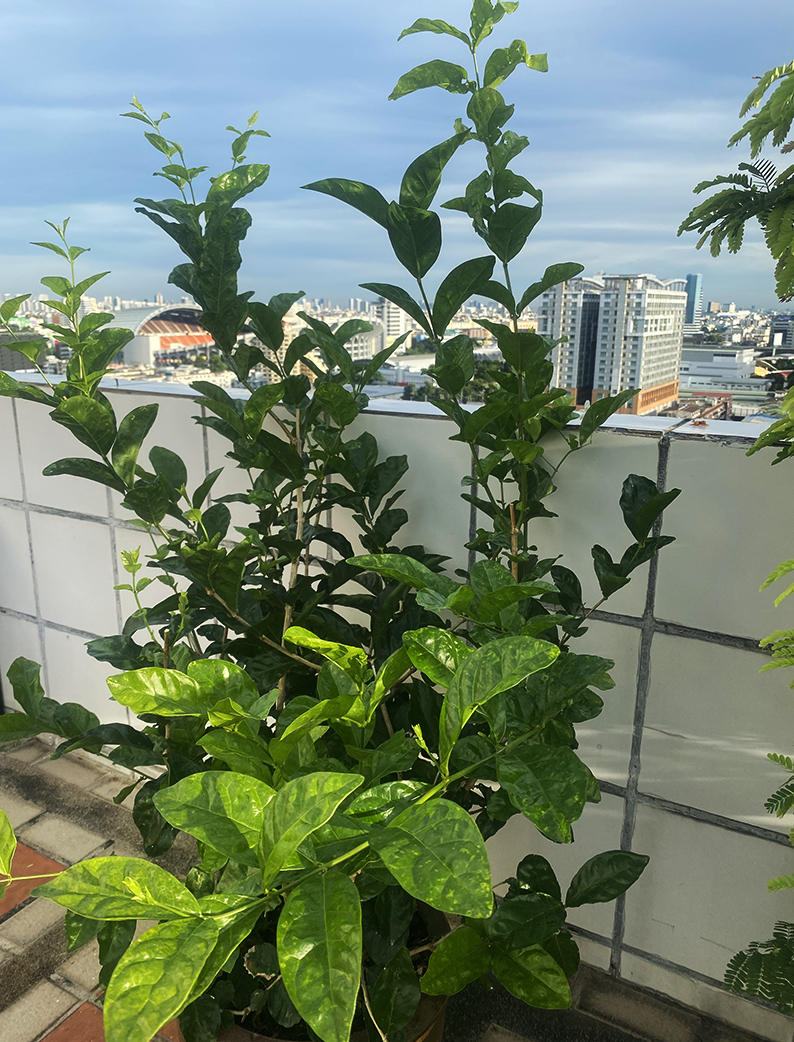
Jasmine, (genus Jasminum)
Jasmine, also spelled jessamine, genus of about 200 species of fragrant-flowered shrubs and vines of the olive family (Oleaceae). The plants are native to tropical and to some temperate areas of the Old World. Several are cultivated as ornamentals.
Most true jasmines have climbing branches without tendrils. The white, yellow, or rarely pink flowers are tubular with a flaring, lobed, pinwheel-like form; some double-flowered varieties have been developed. The leaves can be evergreen or deciduous and usually are composed of two or more leaflets, although some species have simple leaves. The fruit in most species is a two-lobed black berry.
Common jasmine, or poet’s jasmine (Jasminum officinale), native to Iran, produces fragrant white flowers that are the source of attar of jasmine used in perfumery. It is widely cultivated for its shining leaves and clusters of flowers that bloom in summer. Winter jasmine (J. nudiflorum), a Chinese species with solitary yellow flowers, is used as a cover plant on hillsides. Japanese, or primrose, jasmine (J. mesnyi) is a similar plant with larger flowers that bloom during the winter. Italian jasmine (J. humile), a vinelike shrub with yellow flowers, has many cultivated varieties. The fragrant dried flowers of Arabian jasmine (J. sambac) are used to make jasmine tea.
|
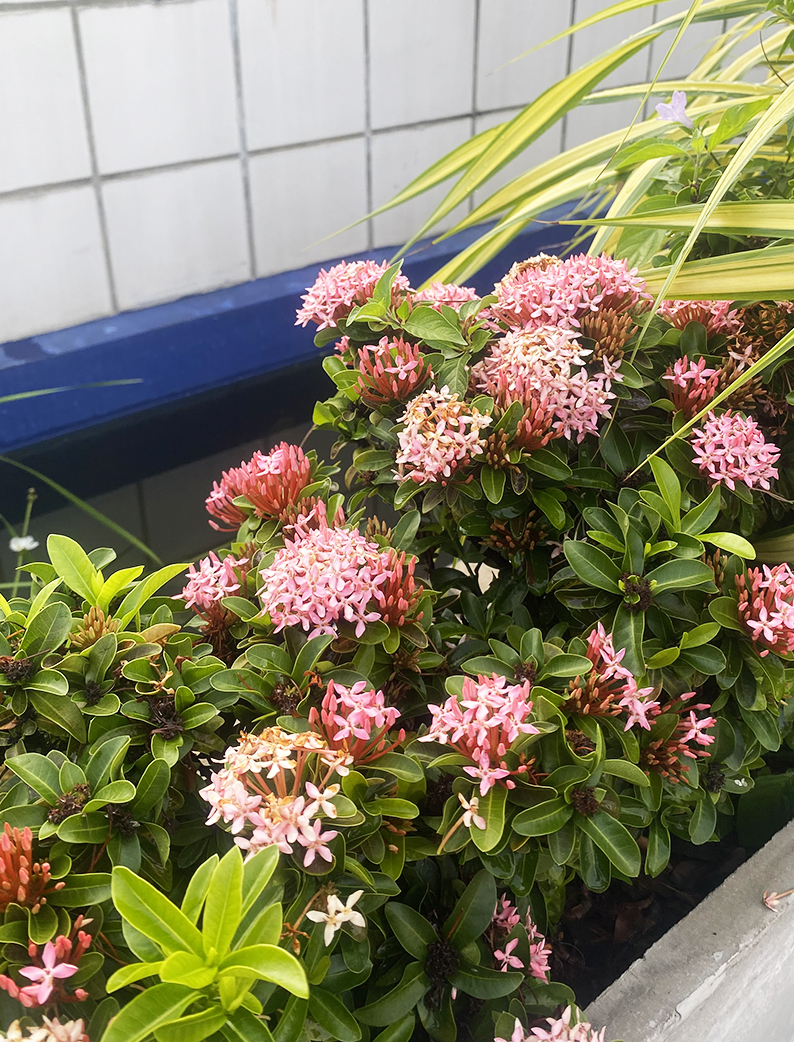 Ixora coccinea Ixora coccinea
Jungle Geranium, Flame of the Woods, Jungle Flame, Scarlet Jungleflame
Ixora coccinea is a common flowering shrub native to Southern India and Sri Lanka and widely cultivated in Indonesia, Malaysia, the Philippines, Vietnam, Cambodia, Laos and Thailand. It has become one of the most popular flowering shrubs in South Florida – USA gardens and landscapes.
It grows in tropical areas with in medium annual rainfall in well drained soils. Ixora coccinea is a low-growing tropical shrub notable for its bright coloured flowers which are composed of many small blooms massed together into dense, flat-topped flower heads. Ixora coccinea is one of the few Ixora species that make good indoor plants along with several kinds developed from it.
It takes up to five years for Ixora coccinea to grow to its maximum height of about 1.2m (4 feet). It is a much-branching shrub, with leathery, shiny, pointed oblong leaves up to 10cm (4 inch) long and 5cm (2 inch) wide arranged in pairs or whorls of three or more in 1-2cm (0.4-0.8 inch) long stalks. Leaf colour is dark green, often bronzish when the leaves are new. Tubular flowers, which are up to 5cm (2 inch) long and fiery red, open at the month into four petals arranged in the form of a cross about a centimetre (0.4 inch) wide. The entire flower head has a diameter of 8-12cm (3-5 inch). Normal flowering period is summer, but occasional flowers also appear in the autumn.
|
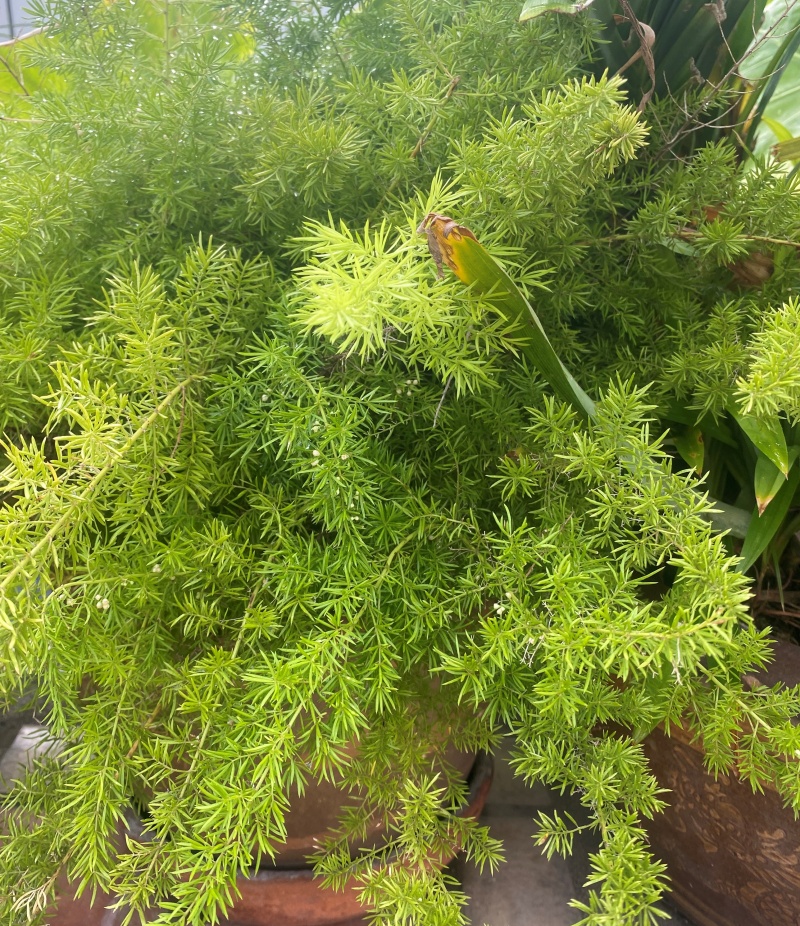 Foxtail fern (Asparagus densiflorus) Foxtail fern (Asparagus densiflorus)
Asparagus Fern, Emerald Fern, Basket Asparagus
Asparagus densiflorus is a scrambling, slightly woody plant with upright or trailing branches up to 1m (3 feet) long. These long, arching stems are densely covered with short, needle-like leaflets that give this plant a delicate appearance. It has a cascading habit being ideal for a hanging basket.
The structures that most refer to as leaves are actually leaf-like branchlets called cladophylls. These tiny cladophylls are linear, flattened structures that are bright green in colour. They occur singly or in groups of 3 or more at a node.
The stems of this plant emerge directly from the ground and become woody and spiny, so care should be taken when handling this species. The thorns cause significant irritation to many people that handle the plant.
Asparagus densiflorus flowers are small, most often white or pale pink and are very sweetly scented. The flowers are not very noticeable, as they are half hidden by the foliage and do not last long. They flower for about two weeks during the summer season. The flowering of the plants can be rather erratic, with the plants having a good flowering year on average only once every three years. The small flowers are followed by showy bright red berries, which each have one large black seed in them. The berries are attractive to birds and may be spread by them.
These plants have extensive root systems with fairly large tubers which are used in nature to deposit the nutrients needed during long periods of drought in summer.
|
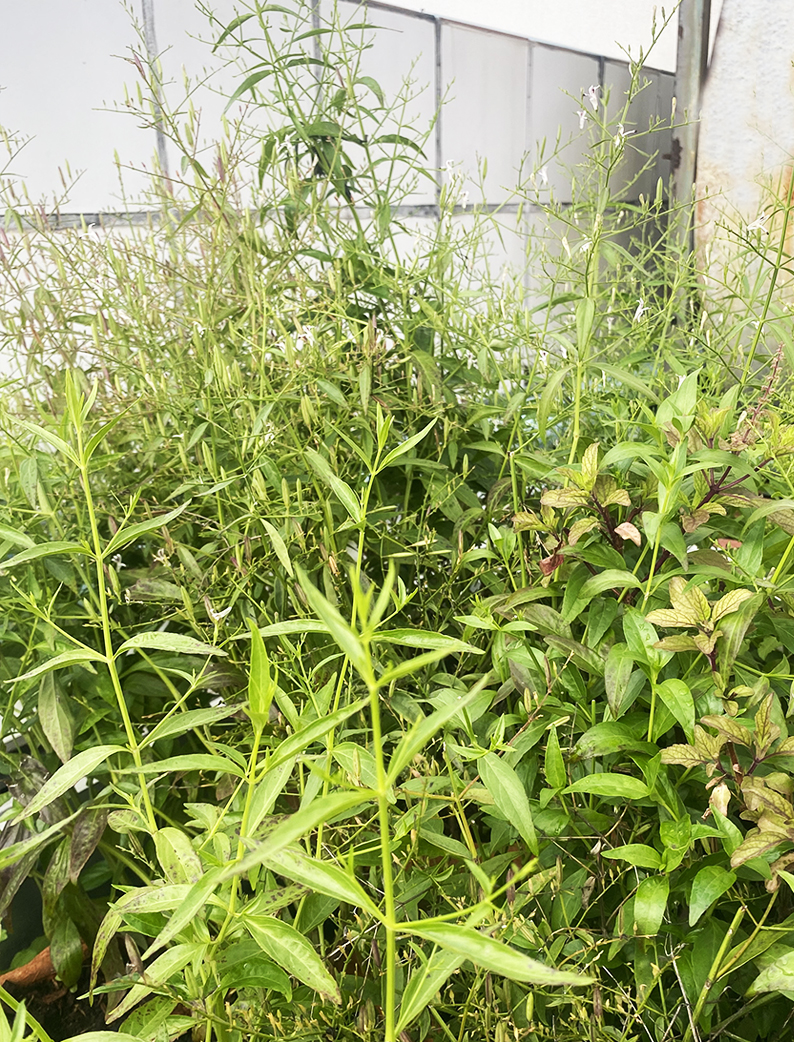
Andrographis paniculata, commonly known as creat or green chiretta, is an annual herbaceous plant in the family Acanthaceae, native to India and Sri Lanka.
It is widely cultivated in Southern and Southeastern Asia, where it has been traditionally been believed to be a treatment for bacterial infections and some diseases. Mostly the leaves and roots were used for such purposes. The whole plant is also used in some cases.
The plant grows as an erect herb to a height of 30–110 cm (12–43 in) in moist, shady places. The slender stem is dark green, square in cross-section with longitudinal furrows and wings along the angles. The lance-shaped leaves have hairless blades measuring up to 8 cm (3.1 in) long by 2.5 cm (0.98 in). The small flowers are pink, solitary, arranged in lax spreading racemes or panicles. The fruit is a capsule around 2 cm (0.79 in) long and a few millimeters wide. It contains many yellow-brown seeds. The seeds are subquadrate, rugose and glabrous. The flowering time is September to December.
|
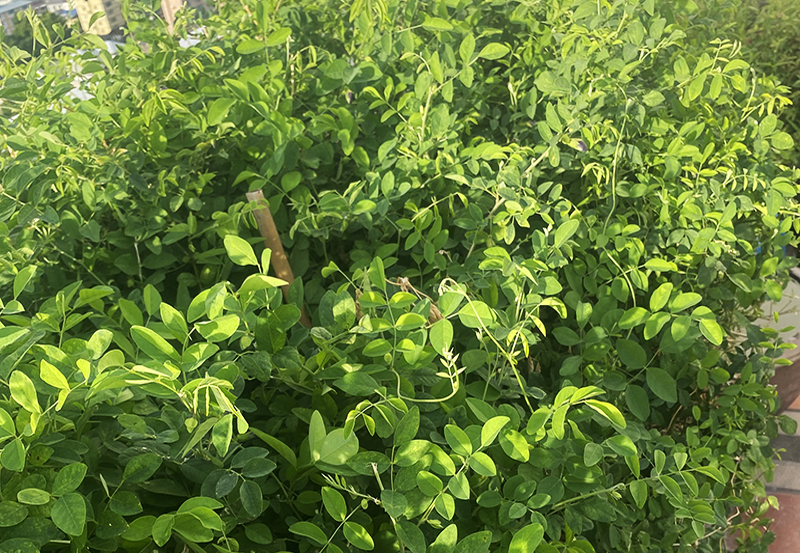 Butterfly Pea Butterfly Pea
Clitoria ternatea, commonly known as Asian pigeonwings, bluebellvine, blue pea, butterfly pea, cordofan pea and Darwin pea, is a plant species belonging to the family Fabaceae.
In India, it is revered as a holy flower, used in daily puja rituals. The flowers of this vine were imagined to have the shape of human female genitals, hence the Latin name of the genus "Clitoria", from "clitoris". The species name is thought to derive from the city of Ternate in the Indonesian archipelago, from where Linnaeus's specimens originated.
It is a perennial herbaceous plant, with elliptic, obtuse leaves. It grows as a vine or creeper, doing well in moist, neutral soil. The most striking feature about this plant is the color of its flowers, a vivid deep blue; solitary, with light yellow markings. They are about 4 cm (1.6 in) long by 3 cm (1.2 in) wide. Some varieties yield white flowers.
The fruits are 5–7 cm (2.0–2.8 in) long, flat pods with six to ten seeds in each pod. They are edible when tender.
It is grown as an ornamental plant and as a revegetation species (e.g., in coal mines in Australia), requiring little care when cultivated. As a legume, its roots form a symbiotic association with soil bacteria known as rhizobia, which transform atmospheric N2 into a plant-usable form (a process called nitrogen fixing), therefore, this plant is also used to improve soil quality through the decomposition of nitrogen rich plant material.
|
| |
|
Sources :
Hutto, W. (1998). Tropical herbs & spices of Thailand. Bangkok: Asia Books.
Jacquat, C. (1990). Plants from the markets of Thailand. Bangkok: Duang Kamol.
Japan International Research Center for Agricultural Sciences
(https://www.jircas.affrc.go.jp/project/value_addition/Local_Vegetables_of_Thailand_home.html)
Wikipedia: The free encyclopedia. (https://en.wikipedia.org)
|


















